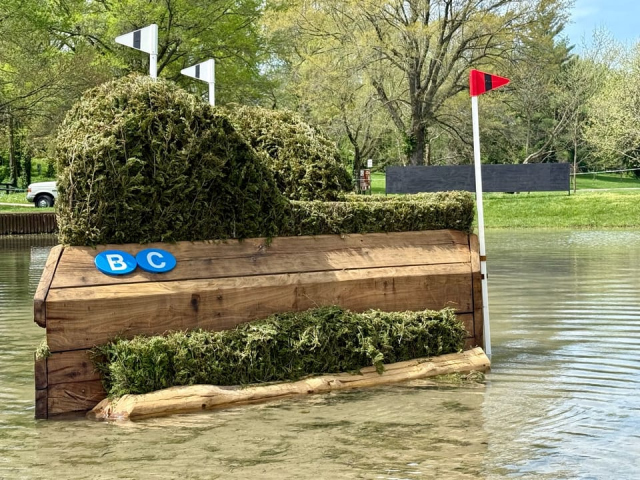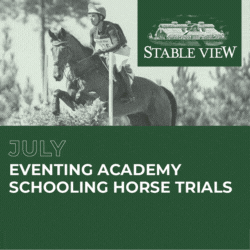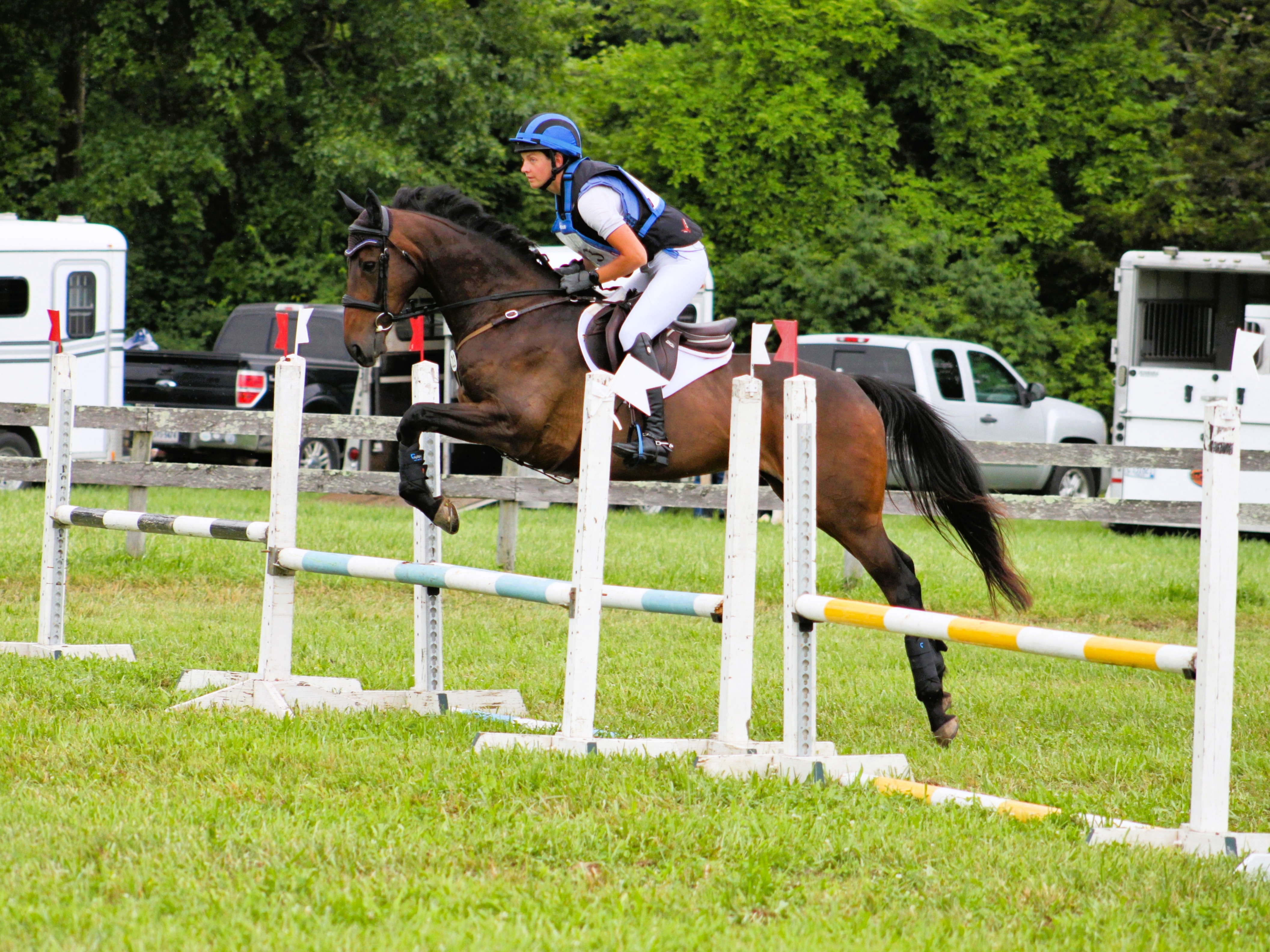It’s nearly go time for a highly anticipated cross country today at Defender Kentucky Three-Day Event, presented by MARS Equestrian. As usual, Derek di Grazia has set an up to snuff challenge for both the 4* (who are we kidding, 5*-S) and 5* riders. The course this year has some change to it — some riders have noted that it feels more twisting than past years — and it’s also using the opposite direction that sees iconic fixtures such as the Head of the Lake and the Park Question coffin coming at different points on the course from the 2024 version.
As usual, CrossCountryApp has put together a guided tour of the course that can be here. We’ll also embed each course below. Derek took some time to speak about the various questions on course and what went into designing them, and it’s well worth a listen if you want to really study this track as a big picture of moving parts.
“This year the direction has changed again from last year,” Derek explained. “The feature fences will come up in a little bit of a different order, and you’ll see a lot of single fences in new places – combinations will be quite different. The distance is maybe a hair longer than last year but still right around 11 min 20 seconds.”
You can see some more comparison of the track to its previous iteration below:
Here’s a look at some of the questions on course, and what Derek said about them:
4ABC: MARS Sustainability Bay
“The big thing about when they come to this fence is there are a lot of people here—around the whole complex. For a lot of horses, it’s quite eye-opening for them. But should be straightforward, but it’s their first water complex — they’ll have plenty to look at. Really the alternative here is only if they have a problem on the direct way.”
Our first combination comes at the MARS Sustainability Bay, getting the horses’ feet wet early and also letting them know that hey, there’s a crap load of people out here. It’s of note that the horses don’t drop directly into the water here; Derek has set this question up nicely to be a nice first real challenge, allowing the horses to land on solid ground before they have to get into the water and react accordingly.
Riders will see a somewhat similar question at the Rolex Crossing later on in the course that demands more technicality, but this question should see most people going direct from A to B in the water to C on a left turn out of the water. Derek’s utilized a lot of narrow fences on this course, and riders will begin to gather intel on their horses and what they may need to mind later down the road based on how they answer this early challenge.
6ABCD – Care Credit Park Question
“They’ve already had the MARS water — that was sort of like a warm-up first combination. They’ve had a bit of a gallop and so then they come here, and they really do have to make sure that they have their horses ready and in gear, because it will all come quite quickly. The horses have to be brave here, and the riders have to be in a good position to be ready for what might happen.”
The coffin comes early on course and presents a navigation challenge to the riders. Derek’s gone with brush here this year, creating a narrow angle in before jumping the ditch at B and holding their line for a second narrow angle at CD.
11 – Angled Hedge and 12ABC – Rolex Crossing
- Fence 11 on course. Photo via CrossCountryApp.
This question is one of the most buzzy to us here at EN (which we’re about 50-50 on in terms of track record on whether or not said buzzy question is actually influential or not), as the Angled Hedge at 11 certainly lives up to its name in terms of its relation to the Rolex Crossing at 12ABC. En route to 11, the riders will have flown the famous Ditch Brush at 10 and will have to sit up to sweep around the left turn to 11, lining up their angle and testing their bravery to ensure a straight shot to the drop into the water at 12.
14ABC – Pete’s Hollow
“Pete’s Hollow has been on the track for quite a number of years, and this year we’re approaching it in a little bit of a different way. It’s at one of the highest points on course — they’re going to have a very simple set of rails jumping in, but the key is once they jump over the rails, they go straight down the slope. So all the way through they’re dealing with not only these very thin rails—which are all on frangible devices—but at the same time they’re dealing with the terrain. They’ll really have to ride forward up the slope, and the horses will have to be good with their feet when they get to the top.”
The Hollow is another perennially influential question on course, this year looking especially challenging in the way it’s been built and the type of jumps that have been used. The roller coaster of terrain here is exacerbated by the long uphill pull the horses have had, though the Hollow is placed just around the halfway mark and the horses won’t always be feeling the effects of their efforts just yet. The upright, frangible rails at A are followed by a sloping downhill to uphill turn met by a very airy triple bar arrowhead at both B and C. By the time they’ve completed the direct route, riders will have done a very challenging S-turn on terrain, and navigated two very narrow, very unforgiving skinnies on top of that.
15ABC – Root Cellar
“I think the riders are going to figure out what strides they wanna do — and it’s really gonna depend on how the horse is feeling, what’s actually happening underneath them.”
Derek di Grazia again here wants riders to sort out their distances based on the horse underneath them. Riders will jump off a bank that will remind many of the famous drops-into-space like the Burghley Leaf Pit or the Morven Park Leaf Pit. They’ll then not have more than a stride to get their wits back about them and get onto the right side of gravity to make a left-handed turn to a pair of angled cabins that are strategically placed in relation to a tree to create an optical challenge.
18ABCD – Defender Head of the Lake
The Defender Head of the Lake is the most recognizable complex at Kentucky, and it’s always a bit of alphabet soup in terms of route options and combinations. The question asked here is made more complex by the massive crowds that gather in the early hours of the morning to secure the best vantage point. As Jon Holling pointed out in Ride iQ’s virtual course walk (viewable here), the look and, certainly, feel of the Head of the Lake changes significantly with the addition of people. Generally, the riders say their horses certainly notice the crowds but don’t always spook at them. And for any horse that’s not been around Kentucky or another 5* in the past, it’s always a bit of “will they or won’t they?”
Which isn’t a question you really want to be answering when swanning over the log at the A element and down a drop with only a few strides to get your line for the rapidly-approaching B element, a yawning brush corner. A relatively small (lol) bank up to a right-handed corner greets the competitors on the way out, and getting there becomes a question of reading the horse’s stride underneath you and not remaining beholden to a specific number of strides (really, a hallmark of cross country riding).
20ABC – Normandy Bank
Approaching the Normandy Bank after a gallop up the hill requires riders to sit their horses down and create a “punchy” stride (not backwards — punchy, Sharon White reminded when I accompanied her on part of her walk with Matt Brown earlier this week, referring to the concept of directing the horse’s weight onto their hind end and creating power to throttle down, rather than pulling the impulsion out of them after the run up the hill) to elicit a clean jump up the bank and up over the cabin with enough maneuverability to hold the direct line. It walks in three directly, but there also exists the option to create a slight bend in the line by landing straight and creating a cleaner view of the C.
If all else fails, or if a rider simply feels their horse could use the extra time and slightly friendlier line, the right side hedge sits a short distance further from the B, providing an option should it be needed.
During their Ride iQ course preview, Kyle Carter and Jon Holling opined that this would be one of the more influential questions on course, and particularly with its placement later on in the going, they could certainly be correct in that thought.
From there, riders have a few more combinations that will test their horses’ rideability as the fatigue begins to set in. The terrain continues to undulate as they near the finish, and the Mighty Moguls at 25AB (the final combination on course) tend to be on the influential side at the end. This year, they’ll jump a narrow brush oxer and bend to the left to catch a right-handed brush. Both fences are built with sloped faces to ensure their friendliness to a tiring horse, but the downhill pull of this question is likely to catch out a horse that’s just off the bridle.
The Lucky Horseshoe at 27 will be a welcome sight for these 5* pairs, who will have run for over 11 minutes by the time they get to this point. It remains to be seen how many will catch the time, but it’s certainly not an easy course to do so on. Who will be the last rider standing? We’ll be keen to find out!
Official Course Preview:
Ride iQ Course Preview:
5* course:
4* course:
Cross country gets underway today at 9:30 a.m. for the 4* and 1:30 p.m. for the 5*. Be sure to tune in to Cheg’s live blog for both divisions, and you can use the links below to watch live. Stay safe everyone, and Go Eventing!
Defender Kentucky: [Website] [Tickets] [Official Schedule] [Entries & Ride Times] [Scoring] [XC Maps] [ClipMyHorse Live Stream] [USEF Network on ClipMyHorse Live Stream] [EN’s Coverage] [EN’s Form Guide]
EN’s coverage of Defender Kentucky is supported by Kentucky Performance Products. To learn more about Kentucky Performance Products’ science-backed nutritional support products, click here.

















































